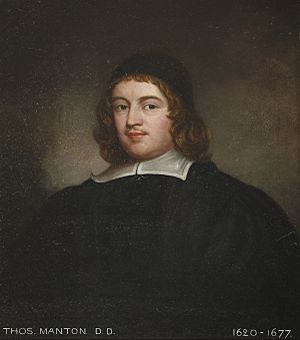Thomas Manton facts for kids
Thomas Manton (born 1620, died 1677) was an English Puritan clergyman. He was a secretary for the Westminster Assembly, which was a group that helped shape church rules. He also served as a chaplain (a religious advisor) to Oliver Cromwell, a powerful leader in England at the time.
Contents
Early Life and Education
Thomas Manton was born in a small village called Lydeard St Lawrence in Somerset, England, and was baptized on March 31, 1620. He likely went to a grammar school called Blundell's School. Later, he studied at Wadham College at the University of Oxford and earned his degree in 1639 from Hart Hall. The next year, a bishop named Joseph Hall made him a minister. Thomas Manton believed this first step was enough and didn't take any further steps to become a priest.
Early Ministries (1640–1645)
After finishing his studies, Thomas Manton started working as a preacher. From 1640 to 1643, he served in a town called Sowton in Devon. Then, from 1643 to 1645, he worked in Colyton, Devon.
Ministry in Stoke Newington (1645–1656)
In July 1645, Thomas Manton moved from the countryside to the London area. He became the minister at St. Mary's church in Stoke Newington, a small town near London. Here, he became well-known for his mid-week lectures, where he taught about different parts of the Bible.
He was invited to preach to the English Parliament at least six times. His first sermon to Parliament was on June 30, 1647. He also helped with the Westminster Assembly as one of its secretaries. Later, he was asked to write an introduction for an important church document called the Westminster Confession in 1658. He also worked for Oliver Cromwell as a chaplain and as a "trier," which meant he helped check if men were ready to become ministers.
Ministry in Covent Garden (1656–1662)
In 1656, Thomas Manton moved into London itself. He became a lecturer at Westminster Abbey and, most importantly, the main minister at St. Paul's, Covent Garden. During this time, Oliver Cromwell died, and England faced a lot of uncertainty. Because of this, many Presbyterians, like Manton, wanted Charles II to return to the throne. Manton even traveled to the Netherlands in 1660 to help with the discussions for Charles II's return.
After Charles II became king again, Manton was part of important talks called the Savoy Conference. This was where Presbyterians and other groups discussed their concerns about the official church prayer book. However, a new law called the Act of Uniformity 1662 was passed in 1662. This law said that all ministers had to be ordained by a bishop, reject certain agreements, promise loyalty to the Prayer Book, and agree to the Thirty-Nine Articles (church beliefs).
Because Thomas Manton was on good terms with King Charles II, he was offered a high position as the Dean of Rochester. But he refused because of his beliefs and conscience.
After the Great Ejection (1662–1677)
Thomas Manton's last years were challenging. The Act of Uniformity led to what was called the "Great Ejection." On August 17, 1662, Manton preached his last sermon at Covent Garden. A week later, on August 24, 1662, he, along with almost 2,000 other Puritan ministers, resigned from their church positions as a protest against the new law.
Even though he no longer had an official church job, he continued to preach from his home in Covent Garden. He also kept writing, even when he was put in prison for six months in 1670 for not following a law called the Conventicle Act, which limited religious meetings.
In 1672, a new rule called the Declaration of Indulgence allowed ministers like Manton to preach from their homes again. Manton then became a lecturer at Pinner's Hall. However, Parliament took back this permission the next year. Thomas Manton died on October 18, 1677. He was survived by his wife and three children.
Legacy and Works
Even though Thomas Manton is not as well-known today, he was highly respected in his time, just like other famous thinkers such as John Owen. He was especially known for his excellent preaching, where he explained the Bible in detail. Later, famous preachers like John Charles Ryle and Charles Spurgeon admired his work.
Ryle said that Manton was "a man who could neither say, nor do, nor write anything without being observed." Spurgeon described Manton's writings as "a mighty mountain of sound theology" and his sermons as "second to none" among his peers. Spurgeon also noted that Manton "is not brilliant, but he is always clever; he is not oratorical, but he is powerful; he is not striking, but he is deep."
His most famous work is likely his Exposition of James, which is a detailed explanation of the Bible's Book of James.
- One hundred and ninety sermons on the hundred and nineteenth Psalm (3 volumes)
- A practical commentary, or, An exposition with notes upon the Epistle of James (several editions)
Complete Works
Thomas Manton's complete works were published in 22 volumes. These include:
- Detailed explanations of parts of the Bible, like the Lord's Prayer, Isaiah 53, the Epistle of James, and the Epistle of Jude.
- Sermons on various topics and specific Bible verses.
- Discourses on peace and holiness.
- Treatises on faith and self-denial.


